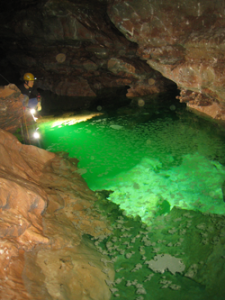High Arsenic Levels Discovered in Wind Cave Water
A new U.S. Geological Survey report has found high concentrations of arsenic in the lakes within Wind Cave.
Likely naturally occurring from shale layers in overlying rocks, the concentrations of arsenic exceeds 10 micrograms per liter, the maximum contaminant level allowed for drinking-water according to the U.S. Environmental Protection Agency.
“This study points out the fact that part of what makes the park a geologic wonder also creates challenges for the water supply.” – Marcia McNutt, USGS Director
In addition to the arsenic, the study also found that the water may be flowing among various connected cave water bodies within the park. Fluorescein dye injected into one of the lakes in Wind Cave was soon detected in two other cave water bodies within the park.
The dye traveled between the bodies of water at a minimum speed of nine meters per day, a very fast rate of flow for ground water.
“This indicates that groundwater in Wind Cave is connected to a unique aquifer consisting of a network of underground pipes.” – Dr. Andrew Long, USGS hydrologist and lead author of the report
Further chemistry analysis of the water in Wind Cave has found that it consists of a mixture of local precipitation and groundwater from multiple aquifers.
Arsenic Concentrations High in Wind Cave Water Bodies [U.S. Geological Survey]



Comment